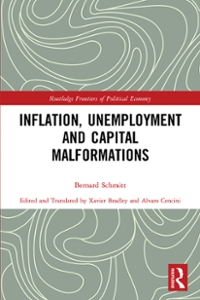Problem 2.7. Using the information from the previous problems. we know that the relationships in the economy can be described using the following equations: ' 1t=1rf+(Y-F)+6 where rrt denotes the actual ination in period t and 1:9 is the expected inflation for that period, and Y, is the actual production and V stands for potential production; B _ n", " "rt1 it = re + 11," + 910'; ?) + 920:: _ ntarget) where re is the natural interest rate and marge, this is the central bank's ination target. It is also known that the equilibrium in the goods market can be represented by the following equation: I Yt=E-a(rt-re)+vt where the real interest rate rt is equal to rs = i5 nf. In the above model 6, v stand for are exogenous shocks regarding prices and production. respectively. a) What type of ination expectations are we dealing with in this exercise? b) Indicate the formula that corresponds to the IS function of the IS-LM model. 0) Identify the equation that describes the monetary policy. d) Find the aggregate demand AD function. e) Derive the function of aggregate supply AS. f) Visualize this model on the appropriate graph. g) What will happen if the central bank lowers its ination target? Show the change on the chart. h) What happens if the economy experiences an exogenous price shock ( 51 > 0). Present the change on the chart and describe the course of the economic adjustment. Then assume that the individual parameters for this economy are: a: re 6'1 62 93 \"target 5 Y 1 1% 0.5 0.5 0.25 2% 1 1 i) determine the level of inflation. production and interest rate in the economy in the long run (the so- called steady state). Question 2.1. True or faise? "The availability of money does not affect economic growth only in the short term" Question 2.2. For discussion What impact does independence from the government have on the credibility of a central bank? What could be the consequences of the central bank losing its credibility? Question 2.3. For discussion What will happen to inflation and inflation expectations, if, using monetary policy tools. the central bank wants to keep the pace of economic growth above the potential level for a longer period of time? Question 2.4. For discussion How short-term interest rates set by a central bank translate into levels of investment and consumption, which are heavily dependent on long-term interest rates







